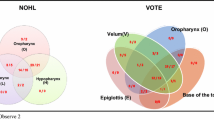Abstract
Drug-induced sleep endoscopy (DISE) and simulated snoring (SimS) are performed as part of the diagnostic procedure in patients with suspected sleep-disordered breathing (SDB). Despite both techniques frequently performed, they have rarely been evaluated yet in terms of agreement of the obtained results. Both diagnostic procedures were performed consecutively in 40 patients with SDB and documented identically. The obtained data were analysed with respect to the agreement of both procedure at different levels of the oropharynx as well as different patterns of obstruction and vibration. The anterior–posterior collapsibility of the soft palate/uvula revealed a moderate agreement between SimS and DISE (κ = 0.42; 95 % CI 0.22–0.63). The dorsal shift of the tongue base agreed moderate for patients with an AHI below 10 (κ = 0.47) and above 25 (κ = 0.44) between SimS ad DISE. The lateral and circular pharyngeal collapsibility at velum and tongue base level did not agree between SimS and DISE, was higher for DISE and could be partially reversed by mandibular protrusion. Collapse patterns of the soft palate and uvula can be induced by SimS and resemble the patterns induced by DISE. The dorsalization of the tongue base can be simulated to a lower extent by SimS. Lateral and circular patterns of collapse at the upper and lower oropharynx induced by DISE do not seem to be simulated by SimS. SimS seems to be an additional method to screen the collapsibility of the soft palate and uvula prior to DISE.



Similar content being viewed by others
References
Herzog M, Kuhnel T, Bremert T, Herzog B, Hosemann W, Kaftan H (2009) The upper airway in sleep-disordered breathing: a clinical prediction model. Laryngoscope 119(4):765–773. doi:10.1002/lary.20153
Croft CB, Pringle M (1991) Sleep nasendoscopy: a technique of assessment in snoring and obstructive sleep apnoea. Clin Otolaryngol Allied Sci 16(5):504–509
Pringle MB, Croft CB (1993) A grading system for patients with obstructive sleep apnoea—based on sleep nasendoscopy. Clin Otolaryngol Allied Sci 18(6):480–484
Babar-Craig H, Rajani NK, Bailey P, Kotecha BT (2012) Validation of sleep nasendoscopy for assessment of snoring with bispectral index monitoring. Eur Arch Otorhinolaryngol 269(4):1277–1279. doi:10.1007/s00405-011-1798-1
den Herder C, van Tinteren H, de Vries N (2005) Sleep endoscopy versus modified Mallampati score in sleep apnea and snoring. Laryngoscope 115(4):735–739. doi:10.1097/01.mlg.0000161347.07881.6d
El Badawey MR, McKee G, Heggie N, Marshall H, Wilson JA (2003) Predictive value of sleep nasendoscopy in the management of habitual snorers. Ann Otol Rhinol Laryngol 112(1):40–44
Iwanaga K, Hasegawa K, Shibata N, Kawakatsu K, Akita Y, Suzuki K, Yagisawa M, Nishimura T (2003) Endoscopic examination of obstructive sleep apnea syndrome patients during drug-induced sleep. Acta Otolaryngol 550:36–40
Johal A, Battagel JM, Kotecha BT (2005) Sleep nasendoscopy: a diagnostic tool for predicting treatment success with mandibular advancement splints in obstructive sleep apnoea. Eur J Orthod 27(6):607–614. doi:10.1093/ejo/cji063
Kezirian EJ, Hohenhorst W, de Vries N (2011) Drug-induced sleep endoscopy: the VOTE classification. Eur Arch Otorhinolaryngol 268(8):1233–1236. doi:10.1007/s00405-011-1633-8
Steinhart H, Kuhn-Lohmann J, Gewalt K, Constantinidis J, Mertzlufft F, Iro H (2000) Upper airway collapsibility in habitual snorers and sleep apneics: evaluation with drug-induced sleep endoscopy. Acta Otolaryngol 120(8):990–994
Berry RB, Budhiraja R, Gottlieb DJ, Gozal D, Iber C, Kapur VK, Marcus CL, Mehra R, Parthasarathy S, Quan SF, Redline S, Strohl KP, Ward SL, Tangredi MM (2012) Rules for scoring respiratory events in sleep: update of the 2007 AASM manual for the scoring of sleep and associated events: deliberations of the sleep apnea definitions task force of the american academy of sleep medicine. J Clin Sleep Med 8(5):597–619. doi:10.5664/jcsm.2172
Herzog M, Metz T, Schmidt A, Bremert T, Venohr B, Hosemann W, Kaftan H (2006) The prognostic value of simulated snoring in awake patients with suspected sleep-disordered breathing: introduction of a new technique of examination. Sleep 29(11):1456–1462
Eichler C, Sommer JU, Stuck BA, Hormann K, Maurer JT (2013) Does drug-induced sleep endoscopy change the treatment concept of patients with snoring and obstructive sleep apnea? Sleep Breath 17(1):63–68. doi:10.1007/s11325-012-0647-9
Pilaete K, De Medts J, Delsupehe KG (2014) Drug-induced sleep endoscopy changes snoring management plan very significantly compared to standard clinical evaluation. Eur Arch Otorhinolaryngol 271(5):1311–1319. doi:10.1007/s00405-013-2795-3
Fernandez-Julian E, Garcia-Perez MA, Garcia-Callejo J, Ferrer F, Marti F, Marco J (2014) Surgical planning after sleep versus awake techniques in patients with obstructive sleep apnea. Laryngoscope 124(8):1970–1974. doi:10.1002/lary.24577
Cavaliere M, Russo F, Iemma M (2013) Awake versus drug-induced sleep endoscopy: evaluation of airway obstruction in obstructive sleep apnea/hypopnoea syndrome. Laryngoscope 123(9):2315–2318
Campanini A, Canzi P, De Vito A, Dallan I, Montevecchi F, Vicini C (2010) Awake versus sleep endoscopy: personal experience in 250 OSAHS patients. Acta Otorhinolaryngol Ital 30(2):73–77
Huo H, Li W, Tian X, Xu C, Wang J, Yang D (2014) Endoscopic upper airway evaluation in obstructive sleep apnea: Mueller’s maneuver versus simulation of snoring. Sleep Breath. doi:10.1007/s11325-014-1073-y
Conflict of interest
There are no institutional or corporate affiliations of the authors and there are no funding sources which supported the work.
Author information
Authors and Affiliations
Corresponding author
Additional information
M. Herzog and P. Kellner contributed equally to the project.
Rights and permissions
About this article
Cite this article
Herzog, M., Kellner, P., Plößl, S. et al. Drug-induced sleep endoscopy and simulated snoring in patients with sleep-disordered breathing: agreement of anatomic changes in the upper airway. Eur Arch Otorhinolaryngol 272, 2541–2550 (2015). https://doi.org/10.1007/s00405-015-3559-z
Received:
Accepted:
Published:
Issue Date:
DOI: https://doi.org/10.1007/s00405-015-3559-z




